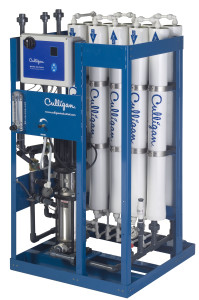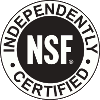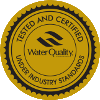Industrial Reverse Osmosis System
Various techniques like desalination, distillation, ion exchange, and reverse osmosis may be used for purifying water. Among these techniques, reverse osmosis is a particularly efficient and cost-effective one. The applications for reverse osmosis include clean drinking water for homes and offices, high-quality water for industrial food and beverage processes, water for commercial uses like carwashes, and portable water purification systems for the military.
Working Principles of Reverse Osmosis Water Systems
Reverse osmosis (RO) uses a semi-permeable membrane to remove dissolved contaminants from water. When feed water flows over one side of the semipermeable membrane under pressure, pure water permeates to the other side of the membrane. The dissolved impurities are caught by the membrane and remain on the feed-water side of the filter.
The semipermeable membrane and the pressure applied to the feed water are the important components of a commercial osmosis water system. RO water systems may also include:
- A pre-filtration stage using a sediment filter to remove undissolved contaminants.
- A chlorine removal stage using a carbon block filter.
- A post-filtration stage for “polishing” the water if it is intended for drinking. This stage uses a carbon filter to remove any fine impurities that may have trickled through the RO membrane.
How Does Reverse Osmosis Work?
The RO membrane essentially acts like a filter that allows only water molecules to pass through while preventing dissolved impurities from doing so. High pressure is applied to the impure water to overcome the osmotic pressure of the membrane and push the pure water molecules through it. RO removes almost all dissolved chemicals, minerals and salts, heavy metals, high molecular weight organic contaminants, and microorganisms. The resulting water is 95-99% pure. The wastewater is typically disposed of in the municipal sewer system.
The capacity of an industrial reverse osmosis system depends on several factors, including:
- Water temperature
- The concentration of dissolved solids in the feed water
- Operating pressure on the feed water.
Benefits of an Industrial Reverse Osmosis System
Industrial reverse osmosis systems offer an array of benefits. Some of the most notable include:
- RO is more cost-effective than other water purification methods, especially when the molecular weight of the dissolved solids exceeds 200.
- RO is more energy efficient than distillation and does not have the corrosion problems that affect distillation systems due to their high operating temperatures.
- Easy operation. Commercial osmosis water systems are easy to install and maintain.
- The water from RO water systems is more environmentally friendly than bottled water.
Reverse osmosis also offers these application-specific benefits:
- For restaurants: Better tasting coffee, tea, and water, and crystal-clear ice cubes.
- For breweries: Better tasting beer.
- For cooking: Better tasting soups and stews.
Reynolds Culligan is a one-stop source for water treatment technologies and services. We have a tradition of innovation that is over 70 years old and our cumulative history in the industry is over 100 years. We supply high-quality and high-output reverse osmosis water systems of various capacities to suit any application.
Contact us today for all your industrial reverse osmosis needs!






